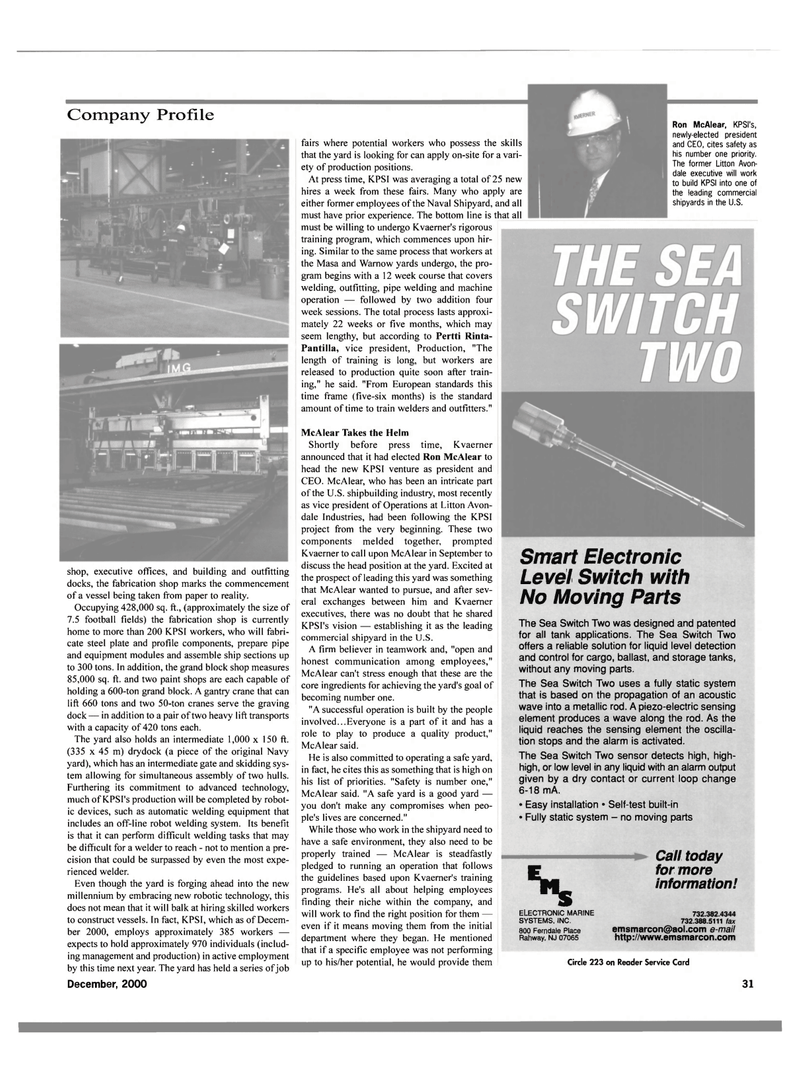
Page 34: of Maritime Reporter Magazine (December 2000)
Read this page in Pdf, Flash or Html5 edition of December 2000 Maritime Reporter Magazine
Company Profile shop, executive offices, and building and outfitting docks, the fabrication shop marks the commencement of a vessel being taken from paper to reality.
Occupying 428,000 sq. ft., (approximately the size of 7.5 football fields) the fabrication shop is currently home to more than 200 KPSI workers, who will fabri- cate steel plate and profile components, prepare pipe and equipment modules and assemble ship sections up to 300 tons. In addition, the grand block shop measures 85,000 sq. ft. and two paint shops are each capable of holding a 600-ton grand block. A gantry crane that can lift 660 tons and two 50-ton cranes serve the graving dock — in addition to a pair of two heavy lift transports with a capacity of 420 tons each.
The yard also holds an intermediate 1,000 x 150 ft. (335 x 45 m) drydock (a piece of the original Navy yard), which has an intermediate gate and skidding sys- tem allowing for simultaneous assembly of two hulls.
Furthering its commitment to advanced technology, much of KPSI's production will be completed by robot- ic devices, such as automatic welding equipment that includes an off-line robot welding system. Its benefit is that it can perform difficult welding tasks that may be difficult for a welder to reach - not to mention a pre- cision that could be surpassed by even the most expe- rienced welder.
Even though the yard is forging ahead into the new millennium by embracing new robotic technology, this does not mean that it will balk at hiring skilled workers to construct vessels. In fact, KPSI, which as of Decem- ber 2000, employs approximately 385 workers — expects to hold approximately 970 individuals (includ- ing management and production) in active employment by this time next year. The yard has held a series of job
December, 2000 fairs where potential workers who possess the skills that the yard is looking for can apply on-site for a vari- ety of production positions.
At press time, KPSI was averaging a total of 25 new hires a week from these fairs. Many who apply are either former employees of the Naval Shipyard, and all must have prior experience. The bottom line is that all must be willing to undergo Kvaerner's rigorous training program, which commences upon hir- ing. Similar to the same process that workers at the Masa and Warnow yards undergo, the pro- gram begins with a 12 week course that covers welding, outfitting, pipe welding and machine operation — followed by two addition four week sessions. The total process lasts approxi- mately 22 weeks or five months, which may seem lengthy, but according to Pertti Rinta-
Pantilla, vice president, Production, "The length of training is long, but workers are released to production quite soon after train- ing," he said. "From European standards this time frame (five-six months) is the standard amount of time to train welders and outfitters."
McAlear Takes the Helm
Shortly before press time, Kvaerner announced that it had elected Ron McAlear to head the new KPSI venture as president and
CEO. McAlear, who has been an intricate part of the U.S. shipbuilding industry, most recently as vice president of Operations at Litton Avon- dale Industries, had been following the KPSI project from the very beginning. These two components melded together, prompted
Kvaerner to call upon McAlear in September to discuss the head position at the yard. Excited at the prospect of leading this yard was something that McAlear wanted to pursue, and after sev- eral exchanges between him and Kvaerner executives, there was no doubt that he shared
KPSI's vision — establishing it as the leading commercial shipyard in the U.S.
A firm believer in teamwork and, "open and honest communication among employees,"
McAlear can't stress enough that these are the core ingredients for achieving the yard's goal of becoming number one. "A successful operation is built by the people involved... Every one is a part of it and has a role to play to produce a quality product,"
McAlear said.
He is also committed to operating a safe yard, in fact, he cites this as something that is high on his list of priorities. "Safety is number one,"
McAlear said. "A safe yard is a good yard — you don't make any compromises when peo- ple's lives are concerned."
While those who work in the shipyard need to have a safe environment, they also need to be properly trained — McAlear is steadfastly pledged to running an operation that follows the guidelines based upon Kvaerner's training programs. He's all about helping employees finding their niche within the company, and will work to find the right position for them — even if it means moving them from the initial department where they began. He mentioned that if a specific employee was not performing up to his/her potential, he would provide them
Ron McAlear, KPSI's, newly-elected president and CEO, cites safety as his number one priority.
The former Litton Avon- dale executive will work to build KPSI into one of the leading commercial shipyards in the U.S.
Smart Electronic
Level Switch with
No Moving Parts
The Sea Switch Two was designed and patented for all tank applications. The Sea Switch Two offers a reliable solution for liquid level detection and control for cargo, ballast, and storage tanks, without any moving parts.
The Sea Switch Two uses a fully static system that is based on the propagation of an acoustic wave into a metallic rod. A piezo-electric sensing element produces a wave along the rod. As the liquid reaches the sensing element the oscilla- tion stops and the alarm is activated.
The Sea Switch Two sensor detects high, high- high, or low level in any liquid with an alarm output given by a dry contact or current loop change 6-18 mA. • Easy installation • Self-test built-in • Fully static system - no moving parts s
ELECTRONIC MARINE
SYSTEMS. INC. 800 Ferndale Place
Rahway, NJ 07065
Call today for more information! 732.382.4344 732.388.5111 tax [email protected] e-mail http://www.emsmarcon.com
Circle 223 on Reader Service Card 31

 33
33

 35
35
